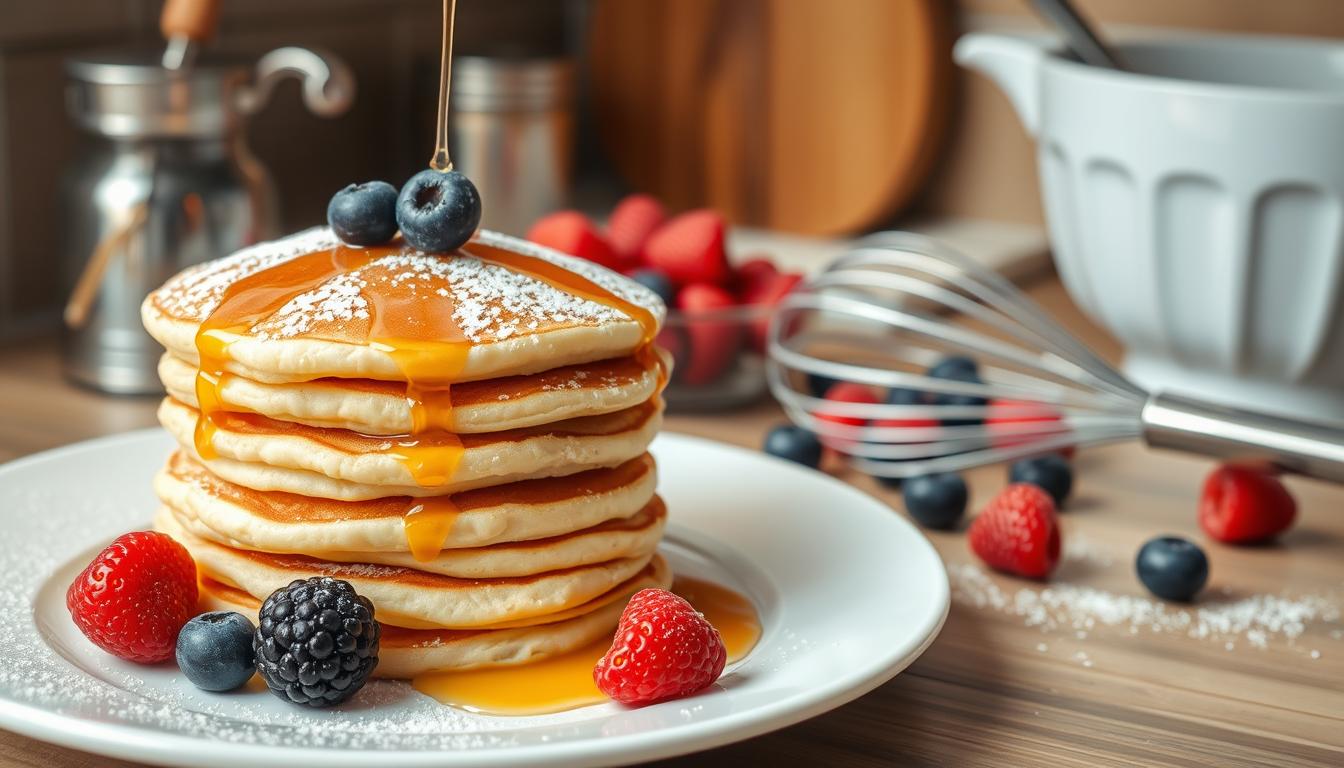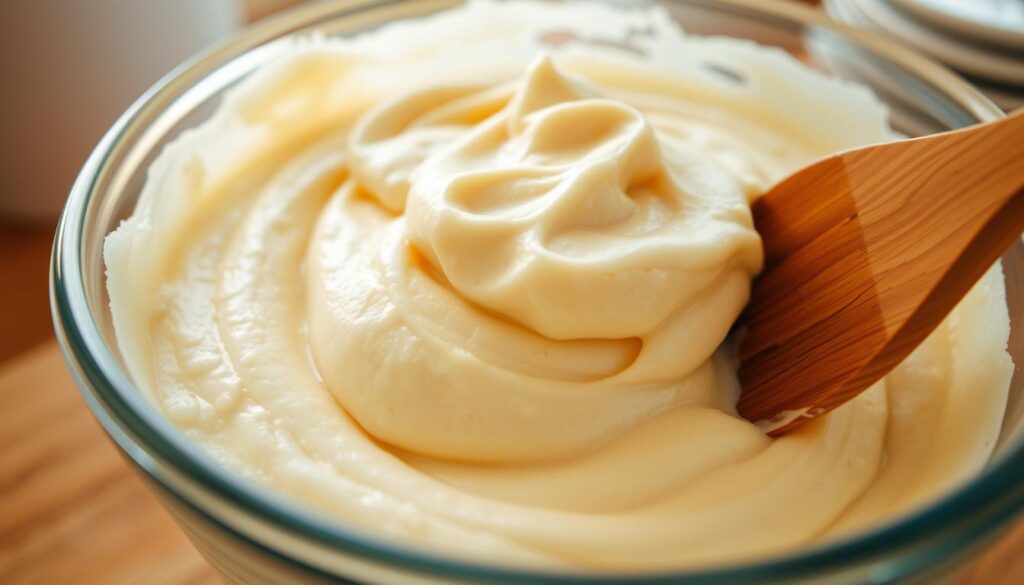There’s nothing quite like the comforting aroma of freshly baked pancakes. It promises a delightful start to your day. But have you ever wondered How to Make the Softest + Fluffiest Pancakes that is pillowy texture and irresistible ? As a self-proclaimed pancake connoisseur, I’m here to share my secrets for the most heavenly pancakes you’ve ever tasted.
Key Takeaways
- Understand the role of different flours in achieving the perfect pancake texture
- Importance of using room temperature ingredients for optimal batter formation
- Discover the right leavening agents to create cloud-like pancakes
- Learn the science behind fluffy pancake texture and how to manipulate it
- Master the art of mixing techniques to ensure your pancakes are light and airy
Whether you’re a seasoned home cook or a novice in the kitchen, this comprehensive guide will equip you with the knowledge and skills to consistently deliver the softest, fluffiest pancakes. Your family and friends will rave about them. Let’s dive in and unlock the secrets to pancake perfection!
Essential Ingredients for Perfect Pancake Batter
Making the softest pancakes starts with the right ingredients. The type of flour and leavening agents are key. Each part is important for the right texture and rise.
The Role of Different Flours
The flour you pick affects your pancakes’ texture. All-purpose flour is a classic, offering a balanced texture. Mixing it with cake flour makes pancakes even fluffier.
Importance of Room Temperature Ingredients
Make sure your ingredients are room temperature before mixing. This ensures a smooth batter. Cold ingredients can make pancakes dense or gummy.
Leavening Agents Selection
Leavening agents like baking powder and baking soda are crucial. Baking powder is the main leavening agent. Baking soda boosts the rise and fluffiness. The right mix is essential for perfect pancakes.
Knowing how each ingredient works together is key. With the right mix, your pancakes will be incredibly soft and fluffy. Your batter will turn into a cloud-like delight.
How to Make the Softest + Fluffiest Pancakes
Making the perfect soft and fluffy pancakes is an art. It needs careful attention to every detail. From measuring ingredients to mixing, each step is important. Let’s explore the secrets to making these cloud-like treats.
Start with the right ingredients. You’ll need all-purpose flour, baking powder, sugar, salt, and milk or buttermilk. Make sure all ingredients are at room temperature. This helps create a smooth batter and ensures they rise well.
- Whisk the dry ingredients together in a large bowl to evenly distribute the leavening agents.
- In a separate bowl, combine the wet ingredients, such as milk, eggs, and melted butter.
- Gently fold the wet ingredients into the dry ingredients, being careful not to overmix. The batter should have a few small lumps remaining.
- Let the batter rest for 10-15 minutes before cooking. This resting period allows the flour to fully hydrate and the baking powder to activate, resulting in fluffier pancakes.
When it’s time to cook, heat a lightly oiled griddle or non-stick pan over medium heat. Use a ladle or measuring cup to portion the batter onto the hot surface. Let the pancakes cook until bubbles form on the surface and the edges begin to set. Don’t flip them too soon. This ensures a perfect golden-brown exterior and a soft, fluffy interior.
The secret to the fluffiest pancakes is in the details. With the right techniques and a little practice, you’ll make restaurant-worthy pancakes. Enjoy your perfectly soft and fluffy creations with your favorite toppings for a delightful breakfast or brunch.
The Science Behind Fluffy Pancake Texture
Creating fluffy, cloud-like pancakes is all about understanding the science. It involves protein content, gluten development, and chemical reactions. Temperature also plays a big role in achieving the perfect pancake.
Protein Content and Gluten Development
The protein in your fluffy pancake batter is key. Proteins in flour mix with water to form gluten. This gluten gives pancakes structure and elasticity.
Too much gluten makes pancakes chewy and tough. Finding the right balance is crucial for a fluffy, tender pancake.
Chemical Reactions in Batter
Chemical reactions in the pancake cooking tips batter also affect texture. Baking soda and baking powder react with acidic ingredients like buttermilk. This reaction creates carbon dioxide bubbles.
These bubbles make pancakes light and airy. They’re what give fluffy pancakes their signature texture.
Temperature Impact on Fluffiness
Temperature is vital for fluffy pancakes. The batter needs to be cooked at the right temperature. This ensures proteins coagulate and leavening agents work well.
If it’s too cold, pancakes are dense. Too hot, and they cook too fast on the outside. The inside stays raw.
By grasping these scientific principles, you can make the softest, fluffiest pancakes every time.
Mixing Techniques for Cloud-Like Pancakes
Making the perfect fluffy pancake batter is an art. The secret is in how you mix it. To get pancakes that feel like clouds, follow these tips:
- Gentle Folding: Don’t stir the batter hard. Use a gentle folding motion. This adds air, making the pancakes light and airy.
- Minimal Mixing: Don’t mix too much. Too much mixing can make the pancakes tough. Stop mixing when everything is just combined.
- Resting Time: Let the batter rest for 10-15 minutes before cooking. This makes the pancakes even fluffier.
Mastering these mixing techniques will help you make fluffy pancake batter. You’ll get pancakes that feel like clouds. Use these pancake cooking tips with top-notch ingredients for the best breakfast.
| Mixing Technique | Impact on Pancake Texture |
|---|---|
| Gentle Folding | Incorporates air, resulting in a light and airy texture |
| Minimal Mixing | Prevents gluten development, avoiding tough, dense pancakes |
| Resting Time | Allows gluten to relax, further enhancing the fluffy texture |
“The secret to light, fluffy pancakes is all in the mixing technique. Treat the batter with a gentle hand, and you’ll be rewarded with a cloud-like texture that melts in your mouth.”
Common Pancake Mistakes to Avoid
Making the perfect pancake is like an art. But with the right techniques, you can avoid common mistakes. This way, you’ll enjoy the softest, fluffiest pancakes every time. Let’s look at some key mistakes to avoid for your next pancake masterpiece.
Overmixing Issues
One big mistake is overmixing the batter. This makes pancakes dense and tough. Instead, gently fold the ingredients together until just combined. Leave a few small lumps in the batter.
Temperature Control Problems
Keeping the cooking temperature right is key for fluffy pancakes. If it’s too hot, the outside cooks too fast while the inside stays raw. If it’s too low, pancakes become dense and greasy. Find the perfect temperature between 350°F and 375°F for golden, light pancakes.
Flipping Timing Errors
Flipping pancakes at the right time is important. Flip them too soon, and they break easily. Wait too long, and they get overcooked. Flip when the edges start to dry and bubbles pop, usually after 2-3 minutes.
By avoiding these common pancake cooking tips, you’ll master making the softest + fluffiest pancakes. With practice and attention to detail, you’ll impress everyone with your pancake skills.
Mastering the Perfect Pancake Griddle Temperature
Getting the griddle temperature just right is key for fluffy, golden pancakes. Whether you’re using a stovetop or electric griddle, knowing how to heat and keep the surface is crucial. This is what makes your pancakes perfect.
First, preheat your griddle well. For the best results, aim for a temperature between 350°F and 375°F (175°C to 190°C). This ensures your pancakes cook evenly. They’ll have a nice crisp outside and a light inside.
- Use a griddle thermometer to check the temperature and adjust as needed. If it’s too hot, pancakes will brown too fast before they’re fully cooked.
- If it’s too cold, pancakes will cook slowly and might be dense and rubbery.
After reaching the perfect temperature, keep it steady. Adjust the heat as you cook. For gas or electric stovetops, tweak the burner setting. With an electric griddle, use the temperature dial.
“The perfect pancake cooking tips start with mastering the griddle temperature. Get it right, and you’ll be rewarded with fluffy, golden-brown breakfast pancakes every time.”
Remember, the griddle’s temperature can change while cooking. Be ready to adjust as needed. A good griddle thermometer helps keep you in the right range for tender pancakes.
Secret Tips for Extra Fluffy Buttermilk Pancakes
Making the perfect fluffy buttermilk pancakes is an art. With a few secret tips, you can get it right. Using the right buttermilk substitutes and letting the batter rest are key. These tricks will make your pancakes light and airy.
Buttermilk Substitutes
Buttermilk is essential for fluffy pancakes. But if you don’t have it, don’t worry. Mix regular milk with lemon juice or white vinegar. Let it sit for a few minutes. This trick gives the same tangy flavor and helps your pancakes turn out fluffy.
Resting Time Benefits
- Letting your pancake batter rest for 10-15 minutes before cooking is crucial.
- This time lets the gluten in the flour relax, making the pancake tender and soft.
- It also helps the leavening agents work better, making your pancakes extra fluffy.
Next time you want the softest, fluffiest buttermilk pancakes, use these tips. Your taste buds and family will love you for it!
“The secret to the fluffiest buttermilk pancakes is all in the technique.”
Creative Pancake Variations and Add-ins
Make your breakfast or brunch special with creative pancake variations and tasty add-ins. Try blueberry pancakes for a burst of juicy sweetness. Or, go for savory options like bacon or cheese-infused flapjacks. Top them with perfect pancake toppings like maple syrup or honey and crushed nuts.
For a unique brunch pancake idea, add fresh fruit, chocolate chips, or cinnamon. Serve with whipped cream, caramelized bananas, or fruit compote. The options are endless to match your taste and wow your guests.
Get creative and show off your cooking skills with pancake variations. Whether you like sweet or savory, classic or new, there’s a recipe to take your breakfast to the next level.
FAQ
What are the essential ingredients for making the softest and fluffiest pancakes?
To make soft and fluffy pancakes, you need a few key ingredients. These include all-purpose flour, baking powder, and baking soda. You’ll also need sugar, salt, eggs, milk (or buttermilk), and melted butter or oil.
How can I ensure my pancake batter is the right consistency?
For the right batter, use room temperature ingredients. Don’t overmix. Gently mix the wet and dry ingredients until just combined. Leave a few small lumps in the batter.
What’s the best way to cook pancakes to get them light and fluffy?
To cook fluffy pancakes, heat your griddle or skillet to 350-375°F. Use a ladle or measuring cup to portion the batter. Don’t flatten the pancakes as they cook. Flip them once, when the edges start to dry and bubbles pop.
How can I make my pancakes extra fluffy with buttermilk?
For extra fluffy buttermilk pancakes, let the batter rest for 15-30 minutes. This lets the buttermilk react with the baking soda. You can also mix regular milk with lemon juice or vinegar as a substitute.
What are some tasty add-ins or toppings for fluffy pancakes?
There are many tasty add-ins and toppings for pancakes. Try fresh or frozen berries, chocolate chips, or chopped nuts. Cinnamon, honey, maple syrup, whipped cream, and even bacon or cheese are great options too.




